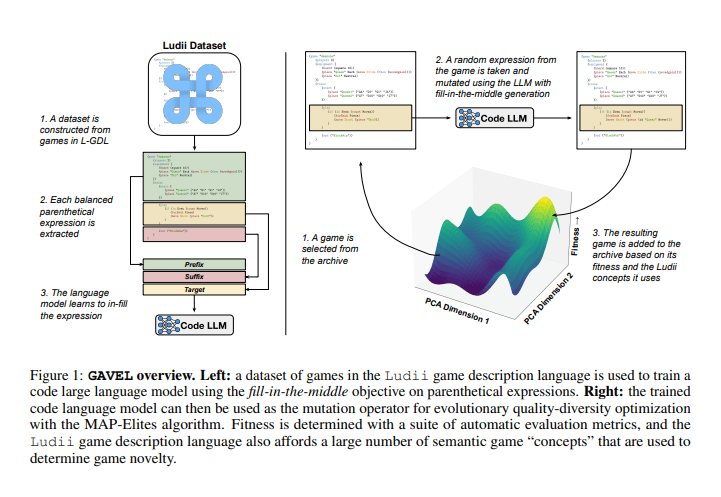- GAVEL integrates large language models and evolutionary algorithms for automated game design.
- Utilizes Ludii game description language with rules from over 1000 board games.
- Employs MAP-Elites for maintaining game variation archives.
- Evaluation using Monte-Carlo Tree Search ensures playability and innovation.
- Generated 185 novel game variations, with 130 playable and 26 high-fitness games.
- Computational efficiency with RTX8000 GPU and 16 CPU cores, completing runs in 48 hours.
Main AI News:
GAVEL, an innovative AI system developed collaboratively by researchers from New York University, Maastricht University, Flinders University, and UCLouvain, represents a paradigm shift in automated game design. By integrating large language models and evolutionary algorithms, GAVEL transforms the landscape of game creation by harnessing the expansive Ludii game description language, which encompasses rules from over 1000 board games.
The system’s approach revolves around leveraging principal component analysis to capture diverse game variations and employing Monte-Carlo Tree Search agents for rigorous evaluation. This method ensures that the generated games are not only playable but also innovative, addressing the longstanding challenge of creating engaging and original game experiences through AI.
In its operational framework, GAVEL utilizes MAP-Elites, an evolutionary algorithm that maintains an archive of game variations, evaluating each for key fitness metrics such as balance, decisiveness, completion, agency, and coverage. The system employs the CodeLlama-13b model to mutate game mechanics, a process that involves extracting and tokenizing game rules into a comprehensive dataset comprising 49,968 tuples.
Results from GAVEL’s trials underscore its capability to produce 185 novel game variations within 500 generations, with 130 of these games deemed playable. Notably, 26 games achieved high fitness scores (fitness > 0.5), highlighting the system’s adeptness at innovating within the game design space. Moreover, GAVEL demonstrated its ability to explore uncharted territories in game design by filling 117 cells with playable games and 26 with high-fitness games, surpassing expectations in both quality and diversity metrics.
Operational efficiency is another hallmark of GAVEL, as evidenced by its utilization of an RTX8000 GPU and 16 CPU cores, completing each iteration in approximately 48 hours. This computational prowess ensures that the system can handle the complex demands of generating and evaluating numerous game concepts within a reasonable timeframe, paving the way for accelerated advancements in AI-driven creative processes.
Overall, GAVEL stands as a testament to the transformative potential of artificial intelligence in expanding the horizons of game design. By intelligently combining mechanics from different genres and exploring novel avenues of creativity, GAVEL heralds a new era of autonomous game development, promising to redefine how games are conceptualized and realized in the digital age.
Conclusion:
The introduction of GAVEL represents a significant advancement in AI-driven game design, enabling the creation of diverse and innovative games at scale. This technology not only enhances creative possibilities but also accelerates the pace of game development, potentially reshaping the market by fostering new genres and gameplay experiences tailored to evolving consumer preferences.

